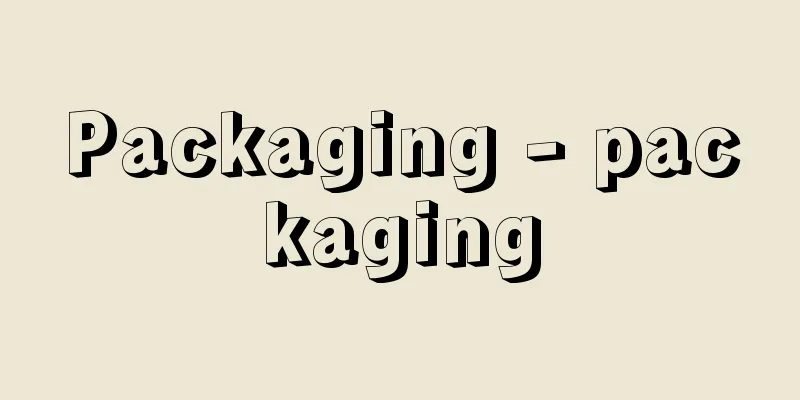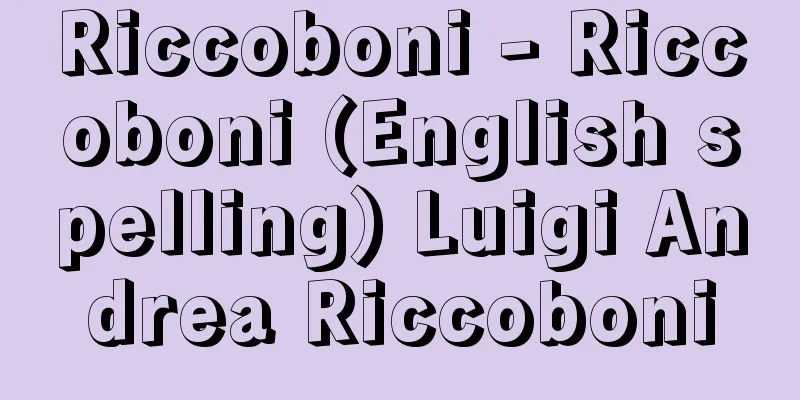Packaging - packaging

|
According to the JIS (Japanese Industrial Standards), packaging is defined as "the storing of goods in suitable materials or containers in order to maintain their value and condition when transporting, storing, trading, using, etc., and the techniques for applying these, or the state in which they are applied. This can be broadly divided into three types: individual packaging, inner packaging, and outer packaging. It is also called packaging." Packaging has also long been called "packaging," but in this case it refers to transport packaging that has no sales promotion function. In America, there is an expression that says "Packaging is marketing," which shows that the emphasis is on the sales promotion function. For example, if we take caramel candy, the wax paper that wraps each candy is the individual packaging, the cardboard box that contains 10 of these is the inner packaging, and the cardboard box in which they are shipped is the outer packaging (transport packaging). For barrel-packed sake, the aroma of the wood (such as cedar or oak) that is used to make the barrel transfers to the sake, improving its flavor, so this type of packaging is ideal. However, packaging that allows impurities to leach into the contents must be absolutely avoided from a safety standpoint. [Haruo Sasaki] Packaging FeaturesThe functions of packaging evolve over time, but the modern functions of packaging can be summarized as follows: (1) Protection and preservation of contents: A function to prevent damage and deterioration of quality from various obstacles and dangers that occur during the transportation, storage, handling, and consumption stages of the product from the producer to the end consumer. (2) Convenience of handling and use: Functions that provide convenience in various aspects of handling and use at the stages of transportation, storage, loading and unloading, sales, consumption, etc. (3) Sales promotion (merchandise) Packaging enhances the value of a product and promotes sales. Prepackaging (pre-packaging for in-store sales) has become common, and self-service sales have become established. As a result, packaging has become a means of accurately communicating the contents to purchasers and consumers and of differentiating products. (4) Providing information Various information functions related to producers, contents, etc. For example, product name, material, type, capacity, handling, place of origin, country of origin, storage conditions, intended use, precautions for use, shelf life (storage period of packaged goods), disposal method, etc. are provided to purchasers and consumers through explanations, diagrams, displays, colors, etc. (5) Cost reduction: Packaging has the function of reducing various logistics costs. (6) Harmony with the environment: Promote "3R + proper disposal." Specific examples include (a) proper packaging that eliminates excessive packaging (Reduce), (b) reuse through refills and returnable containers (Reuse), (c) re-commercialization and resource recycling (Recycle), and (d) ease of waste separation and disposal, and proper detoxification (Proper disposal). (7) Universal Design: Packaging design that takes into consideration the greatest possible usability for all people, such as ease of sorting and identification, ease of opening and resealing, ease of holding, ease of removing contents, ease of pouring, etc. Among these, (6) harmony with the environment is particularly important. Furthermore, the functions required of packaging differ depending on whether it is individual packaging, inner consumer packaging (previously called consumer packaging, but now called consumer packaging, meaning "consumers who make use of it"), or outer transport packaging. However, protective properties are the basic function of packaging and its most important role. It is necessary to protect the contents from external physical forces, insulate the contents from chemical changes, and protect against temperature, humidity, odors, rust, etc. Special notes about consumer packaging and transport packaging are listed below. [1] Marketing through consumer packaging The first is sales promotion (merchandise of packaging) as mentioned in (3) above. Merchandise of packaging is the function of packaging being integrated with the contents to create commercial value. No matter how protective the packaging may be, it is easy to understand that high-quality whiskey in a paper container has little commercial value. Secondly, convenience as mentioned in (2) above is also an extremely important function. Beverages such as canned beer, canned juice and canned coffee are welcomed by consumers because they have stay-on-tabs (tabs that do not come off the can even after opening) on the lids that have an easy-open function. Aerosol packaging, which is used for insecticides and hair lacquers and sprays the contents in a mist just by pressing the valve, is also a typical example of convenience packaging, and even if the price is higher due to the packaging, it sells well because of its functionality. The third is the display function of packaging as mentioned in (4) (provision of information). The manufacturing date and expiration date of food are important to consumers, and displaying cooking methods for microwaves and ovens is also useful. Barcode-based POS (point of sales) marks are beneficial not only to supermarkets and convenience stores, but also to consumers, as they speed up check-out times and eliminate register errors. [2] Types and functions of transport packaging The types and functions can be broadly divided into the following three categories. The first is packaging for consumer packaged products, which are then packaged in cardboard and transported to supermarkets, department stores, convenience stores, and general retailers. In the Heisei era, there was a demand for packaging that would allow products to be displayed in stores simply by cutting a portion of the shipping cardboard box, and for decorative cardboard boxes. The second category is packaging for large items such as televisions and refrigerators, in which the inside is cushioned and fixed with polystyrene foam or urethane foam, and then wrapped in cardboard. This category includes products that have dual-purpose transport packaging and are delivered to consumers as is. Thirdly, there is the transport packaging for automobile parts and electrical parts sent from parts manufacturers to assembly plants, and large-scale flexible container packaging for transporting synthetic resins and other processed food ingredients such as flour and sugar. This sector includes intermediate transport packaging for transporting raw materials, such as cardboard boxes for transporting parts, heavy-duty packaging bags for transporting raw materials, and drums. [Haruo Sasaki] History of Packagingforeign countryThe origins of packaging can be traced back to 3000 BC. It is said that in Mesopotamia, women carried toiletry buckets, and containers for oil-based perfumes were also used at the time. It is also known from papyrus writings that containers for cosmetics and ointments were used in ancient Egypt. It is said that the Persians transported water in earthen jars during the Persian Wars in 530 BC, but because these jars were fragile, they devised packaging in leather bags made from pigskin sewn together. Glass bottles began to be used as packaging containers in the 1600s, replacing clay pots and leather bags. They were very expensive at the time, but eventually bottle-making factories were built in the United States, and in 1889, a rotary automatic bottle-making machine was invented, and glass bottles began to be used as packaging containers in earnest. In 1730, the tinplate industry began in Germany and the United Kingdom, and bottled packaging by heat sterilization of food was born in France. In 1798, the invention of lithography led to the widespread use of colored labels, and printing techniques important to packaging were introduced. In 1494, the first paper mill was built in the United Kingdom, and cylinder-type mechanical papermaking began, and in 1799, the invention of the cylinder-type papermaking machine led to mass production of paper. As a result, paper began to be used in the packaging field in earnest. In 1860, corrugated paper was used in the United Kingdom to make sweatbands for hats (later known as corrugated board), and in 1882, double-sided corrugated board was completed and recognized as a material for transport containers. The bag manufacturing industry emerged in the 1860s, and the development of bag-making machines led to an increase in the use of bags. In 1889, the aerosol container, today's most popular packaging, was patented, and began to be used as a perfume spray package. During World War II, in order to facilitate the transportation of supplies to the wide-ranging operational areas, packaging techniques were developed to protect items from rust, mold, and shock, and instant foods were widely produced for use as field rations. Plastic films, including polyethylene, which was a valuable commodity during the war, gradually made their way into the packaging field, and with the development of plastic film processing machines and automatic packaging machines that used these, the automation of packaging was achieved. The lamination technology using melt extrusion of polyethylene, invented in the United States in 1950, has made a revolutionary contribution to modern packaging. The development of hollow plastic molding technology has made it possible to use plastic bottles to package detergents and edible oils, and the development of vacuum molding machines has led to their use in packaging meat and miscellaneous goods. Electrostatic printing, which was put to practical use in 1962, is proving to be a powerful tool in packaging printing today. [Haruo Sasaki] JapanIn Japan, jars and pots, the origins of packaging, have a history of several thousand years. Many glass containers, such as those found in the Shosoin Treasures, were presented from the continent. In addition to folding screens and picture scrolls, wooden boxes used to transport expensive items such as swords and spears, and lacquered boxes can also be considered packaging containers. Packaging baskets, which are still used today, also have a long history as containers, and were used in the past to transport charcoal and fruit. The ideal packaging container invented in Japan was the straw bag, which was used to pack rice, wheat, vegetables, and fruit, as well as to transport minerals such as sulfur. The sake barrel, which is also still alive today as an ideal container, is an unparalleled container that gives the sake inside the barrel a barrel flavor. Furoshiki wrapping cloths are also widely used as a convenient cloth packaging, and are famous worldwide. Many of the packaging technologies that underpin modern packaging, such as bottled packaging, canned packaging, cardboard packaging, and plastic packaging, were introduced from overseas during the Meiji period and then improved and developed for Japanese use. Japan is a pioneer in packaging, located in a hot and humid region, and has the technological capabilities to lead the global packaging industry in moisture-proof packaging, vacuum packaging, oxygen-removing packaging, and fresh food packaging. [Haruo Sasaki] Technological innovation in packaging materials and containers(1) Paper and Paperboard Packaging Paper has long been used as a packaging material for bags and wrapping paper, and paperboard cartons were used for confectionery and soap boxes, but these uses were merely decorative. Since the success of milk cartons in the United States in 1940 and Tetra Pak in Sweden in 1955, paper and paperboard have been successfully used as liquid containers for milk and juice by making composite materials with polyethylene extrusion coating. In Japan, in 1984, a composite can was made from seven layers of composite material, including paperboard, PE (polyethylene), PET (polyethylene terephthalate), and aluminum vapor deposition, and it was successfully used to package large quantities of juice. Also, the success of ovenable packages that can be cooked directly in a microwave oven, which have been on the market since around 1978, has been a major success. For cardboard used for transport packaging, they have succeeded in creating multicolored cardboard by pre-printing the liner (the outer paperboard of the cardboard), which is used for consumer packaging as well as for large-scale packaging of 10 or 20 liters of liquids such as alcohol and wine as bag-in-boxes (cardboard with a plastic inner bag). Of the total value of packaging material shipments in 2009 (Heisei 21), paper and cardboard accounted for the top proportion at 42% (2.4623 trillion yen) (some estimates). (2) Plastic packaging materials Plastic packaging materials are suitable to occupy the core of modern packaging, and in Japan in 2009 they accounted for 30% of the total, second only to paper and paperboard. Films and sheets account for a large number of uses, and new technology is being developed for multi-layer sheets with high levels of gas barrier properties. The molding machine used by Coca-Cola in the US is a Japanese PET bottle stretch blow machine (a molding machine that heats and melts thermoplastic resin, extrudes it into a pipe shape, and cools it in a mold to create bottles or tube containers), and the technology has also been perfected for co-extruded multi-layer PET bottles with high barrier properties. (3) Metal packaging materials Metal packaging materials accounted for 16% of the shipment value in 2009. This is because they are used for aluminum cans, mainly for beer. The shipment value of metal packaging has been in negative growth since 2005. [Haruo Sasaki] Packaging and the EnvironmentIn Japan, 53.1 million tons of garbage was generated as general waste from households in fiscal 1997, of which "container and packaging waste (containers and wrapping materials)" accounted for approximately 60% by volume. In order to turn this "container and packaging waste" into a "resource," the "Law Concerning Promotion of Separate Collection and Recycling of Containers and Packaging" (commonly known as the Container and Packaging Recycling Law) was partially enacted in April 1997, and was fully implemented three years later in April 2000. The outline of the implementation of these laws is as follows: [1] Recycling targets and methods Glass bottles and PET bottles have been subject to the recycling system since April 1997. Glass bottles are recycled as glass bottles after being turned into cullet (glass scraps for melting). PET bottles are recycled as pellets (spherical granules) after being turned into pellets. In April 2000, plastic containers and packaging (such as polystyrene foam trays) and paper containers and packaging were added to the list of items eligible for recycling. Plastic containers and packaging are recycled as raw materials for plastics, as well as through methods such as oilification, blast furnace reduction, gasification, and recycling into chemical raw materials in coke ovens. Paper containers and packaging are also sorted and recycled into paper raw materials, building boards, and pulverized waste paper, or turned into fuel. [2] Businesses subject to the recycling obligation The businesses subject to the recycling obligation are (1) businesses that use containers (businesses that use containers for sales, etc.), (2) businesses that manufacture containers (businesses that manufacture the containers themselves), and (3) businesses that use packaging (businesses that use packaging for sales, etc.). The implementation from April 1997 started with only large businesses among these businesses, but from April 2000, small and medium-sized businesses were also subject to the obligation. Small businesses are also exempt from the obligation. As mentioned above, the basis of recycling is "3R + proper disposal," and as of 2009 measures had been almost fully established for metal containers, glass containers, and cardboard packaging, and considerable progress had been made with regard to PET bottles as well. The issue is the recycling of other paper containers and packaging, polyvinyl chloride, and other plastic containers and packaging. The key to this is improving sorting and collection through the understanding and cooperation of consumers. Furthermore, displaying a material identification mark has been mandatory since April 2001. [Haruo Sasaki] Issues and future trends(1) Problems with packaging Japan's packaging industry is the second largest in the world after the United States, and in 2009, the industry had grown to a total of 6,298.6 billion yen, with packaging materials at 5,859.2 billion yen (shipment value) and packaging machinery at 439.4 billion yen (production value). However, the size of the packaging industry, which was 2% of the gross national product (GNP) until 1974, has fallen to 1.3% of the gross domestic product (GDP) in 2009. The main reason for this is that the trend toward creating a recycling-oriented society and the economic downturn have made it impossible to expect an expansion in the quantity of products to be packaged. While it is predicted that demand for packaging will continue to peak due to the trend toward resource conservation and non-pollution, some people see a bright future in the creation of new value through improved packaging functionality and the trend toward fashion. (2) The Future of the Packaging Industry It is expected that the performance of functional packaging materials will further improve. With excellent functions such as oxygen absorption, moisture absorption, transparent high barrier, gas selectivity, and freshness retention, the amount of packaging materials used will be reduced, contributing to the stabilization of the quality of food products, etc., which will ultimately contribute to environmental measures and increased added value. Biodegradable plastics, which are decomposed into carbon dioxide and water by microorganisms in soil and water, are expected to be used as environmentally friendly packaging materials in the future, and if their safety is confirmed, they are expected to be used as food containers and packaging materials. In addition, packaging materials with dioxin suppression functions are attracting attention. The generation of dioxins from waste incineration plants has become a major social issue, but a technology has been developed that suppresses dioxins from the source during incineration by incorporating active iron oxide into plastic film. Until now, used plastic film has been treated as a nuisance, and even disposed of in landfills. However, by incinerating it, this technology can be used to cleanly burn the surrounding garbage as well. Combined with its versatility, which allows it to be easily produced using existing facilities, this technology is attracting attention as a powerful means of combating dioxins. Furthermore, with the development of life cycle assessment (LCA) methods, it may become possible to make absolute evaluations of packaging materials and packaging processes. [Haruo Sasaki] "Packaging is the deciding factor in food development" by Mitsu Yoshikane (1983, Japan Food Journal)" ▽ "Fundamental knowledge of packaging materials" (1990), edited and published by the Japan Packaging Technology Association" ▽ "Packaging Technology Handbook" (1995), edited and published by the Japan Packaging Technology Association" ▽ "Industrial Recycling Dictionary Editorial Committee (2000, Industrial Research Institute)" ▽ "Packaging Dictionary" edited by the Japan Packaging Society (2001, Asakura Publishing)" ▽ "Packaging...? Good to know" (2004), edited and published by the Japan Packaging Technology Association" [Reference items] | | | | | | |Source: Shogakukan Encyclopedia Nipponica About Encyclopedia Nipponica Information | Legend |
|
JIS(ジス)(日本工業規格)によると、包装とは「物品の輸送、保管、取引、使用などに当たって、その価値及び状態を維持するために、適切な材料、容器などに物品を収納すること及びそれらを施す技術、又は施した状態。これを個装、内装及び外装の3種類に大別する。パッケージングともいう」と定義づけられている。包装は、また古くから梱包(こんぽう)ともいわれているが、この場合は販売促進機能をもたない、輸送包装のことである。アメリカではPackaging is marketing.(包装は販売促進そのものである)という表現があるように、販売促進機能が重視されていることが理解される。 キャラメルを例にとれば、1粒ずつを包んでいるワックス紙が個装であり、これを10粒包んでいる板紙箱が内装にあたり、輸送するための段ボール箱が外装(輸送包装)である。樽(たる)詰の酒は材料である木(杉やオークなど)の香りが酒に移行し、酒の味わいをよくするものであり、このような包装が理想的なものである。しかし、中身に不純物が溶出するような包装は、安全性の面からも絶対に避けなければならない。 [佐々木春夫] 包装の機能包装の機能は、時代とともに進化するものであるが、現代における包装の機能は以下のとおりにまとめられる。 (1)中身の保護・保全 製品が、生産者から最終消費者の手元に届けられるまでの間の輸送、保管、荷扱い、および消費の段階などで起こるさまざまな障害や危難から、破損や品質低下を防ぎ守るための機能。 (2)取扱いや使用の利便性 輸送、保管、荷役(にやく)、販売、消費の段階などにおけるさまざまな取扱いや使用の利便性のための機能。 (3)販売の促進(商品性) 包装によって商品の価値を高め、販売を促進する機能。プリパッケージ(店頭販売用の事前包装)が一般化し、販売にセルフサービス方式が定着した。これにより、包装は中身を購入者や消費者に適確に伝え、また商品を差別化するための手段となっている。 (4)情報の提供 生産者や内容物などに関するさまざまな情報機能。たとえば、品名、材質、種類、容量、取扱い、産地、原産国、保存条件、対象、使用上の注意、シェルフライフ(包装物品の保存可能期間)、廃棄方法などを説明文、図、表示、色彩などによって購入者や消費者に提供する。 (5)コストの低減 包装することによって物流上のさまざまなコストを低減する機能。 (6)環境との調和 「3R+適正処理」で推進する。具体例として、(a)過大・過剰包装を排した適正な包装(リデュースReduce)、(b)詰め替え、リターナブルなどによる再利用(リユースReuse)、(c)再商品化、再資源化など(リサイクルRecycle)、(d)分別や廃棄物処理の容易さ、無害化処理適正など(適正処理)があげられる。 (7)ユニバーサルデザイン すべての人が、可能な限り最大限利用できるように配慮された包装デザイン。たとえば、選別・識別のしやすさ、開けやすさ・再封のしやすさ、持ちやすさ、中身の取り出しやすさ、注ぎやすさなど。 このなかの(6)環境との調和は、とくに重要となっている。 また、包装の機能は、個装、内装の生活者包装consumer packaging(以前は消費者包装といっていたが、いまでは「生かして活用する生活者」という意味で生活者包装という)と、外装の輸送包装transport packagingによって、求められる機能が異なっている。しかし、包装の保護性は包装の基本的な機能であり、もっとも重要な役割である。内容物を物理的な外力から守り、化学的な変化から中身を遮断し、温度、湿度、臭(にお)い、錆(さび)などから保護することが必要である。次に生活者包装と輸送包装の特記事項を記す。 〔1〕生活者包装によるマーケティング その第一は、前記(3)で示した販売促進(包装の商品性)である。包装の商品性とは、包装が中身と一体になって商品価値を生む機能である。いかに保護性があっても、紙容器入りの高級ウイスキーは商品価値に乏しいことが理解されよう。第二に前記(2)の利便性もきわめて重要な機能である。缶ビールをはじめ、缶ジュース、缶コーヒーなどの飲料は、蓋(ふた)にイージーオープン機能をもったステイオンタブstay-on-tab(開缶後もタブが缶から離れないもの)がつけられることによって、使用者から歓迎されている。またエアゾール包装という、殺虫剤やヘアーラッカーに使われているバルブを押すだけで中身が霧状に飛び出す包装も、代表的な利便性の包装であり、包装によって価格が高くなっても機能で売れている。第三は(4)の包装の表示機能(情報の提供)である。食品の製造年月日や賞味期限は消費者にとって重要であり、電子レンジやオーブンなどでの調理法の表示も有用である。バーコードによるPOS(ポス)(point of sales)マークは、スーパーマーケット、コンビニエンス・ストアだけでなく、消費者にとってもチェック・アウト・タイムが速くなり、レジスターミスがなくなるなどの利点がある。 〔2〕輸送包装の種類と機能 種類、機能を大別すると次の三つになる。 第一は、生活者包装された商品を、段ボール包装して、スーパーマーケット、デパート、コンビニエンス・ストア、一般小売店に輸送するための包装である。平成に入って、輸送用段ボール箱の一部をカットするなどの作業だけで店頭展示ができるような形態と、段ボールの美粧化が求められるようになった。 第二は、テレビや冷蔵庫などの大型商品の包装で、内部を発泡スチロール、ウレタンフォームなどで緩衝固定し、その上を段ボール包装するものである。輸送包装がそのまま消費者に配送される、兼用の機能を備えたものがこの分類である。 第三に、自動車部品、電機部品のように、部品メーカーから組立工場に送られる輸送包装や、小麦粉、砂糖などの加工食品原料を輸送する、合成樹脂などの大型輸送用のフレキシブル・コンテナ包装がある。この分野には、部品輸送段ボール、原料輸送の重包装袋、ドラム缶など、原料輸送のための中間輸送包装が含まれる。 [佐々木春夫] 包装の歴史外国包装の起源は紀元前3000年にさかのぼることができる。メソポタミアでは女性が化粧用の桶(おけ)を持っていたといわれ、油性香水の容器なども当時使われていた。また古代エジプトで化粧品や軟膏(なんこう)の容器が使われていたことがパピルスの書物などによって知られている。ペルシア人は前530年のペルシア戦争の際、土の壺(つぼ)で水を輸送したといわれ、この壺が壊れやすいため、ブタの皮を縫い合わせた皮袋による包装が考案された。 ガラス瓶は1600年代に土の壺や皮袋にかわって包装容器として使われ始めた。当時はきわめて高価なものであったが、やがてアメリカで製瓶工場が建てられ、1889年に輪転式の自動製瓶機が発明され、本格的にガラス瓶が包装容器として使用された。1730年にドイツ、イギリスでブリキ業が始まり、フランスで食品の熱殺菌による瓶詰の包装が誕生した。1798年には石版印刷の発明により、色付きラベルの使用が普及し、包装にとって重要な印刷技術の導入が行われた。1494年イギリスで最初の製紙工場が建設され、丸網式の機械製紙が始まり、1799年には円網(まるあみ)抄紙機の発明によって紙の大量生産が行われるようになった。この結果、包装分野への紙の進出が本格化した。1860年には段をつけた紙がイギリスで帽子の汗取りに使われ(後の段ボール)、1882年には両面段ボールが完成して輸送容器材料として認められた。1860年代に製袋工業がおこり、製袋機の発達が袋の使用を増大させるに至った。さらに1889年には今日の花形包装であるエアゾール容器の特許が認められ、香水のスプレー包装として使用されるようになった。 第二次世界大戦時に、広範な作戦地域への物資の輸送を果たすため、錆、カビ、衝撃から物を保護する包装技術が開発され、野戦食糧としてインスタント化が盛んに行われた。戦時中貴重品であったポリエチレンをはじめとするプラスチック・フィルムが漸次包装分野に進出することとなり、プラスチック・フィルムの加工機械の発達と、これを使用する自動包装機械の開発が進み、包装の自動化が達成された。 1950年にアメリカで発明されたポリエチレンの溶融押出しによるラミネーション技術は近代包装に革命的な貢献をしている。プラスチックの中空成型技術の発展は洗剤や食用油の包装にプラスチックボトルの使用を可能にし、真空成型機械の開発は食肉包装、雑貨包装などに活用されている。また1962年に実用化された静電写真印刷法は今日の包装印刷として威力を発揮している。 [佐々木春夫] 日本日本でも包装の起源である甕(かめ)や壺が数千年の歴史をもっている。また大陸からは、正倉院宝物にみられるような多くのガラス容器が献上されている。屏風(びょうぶ)、絵巻物などのほか、太刀(たち)・槍(やり)などの武器のような高価なものの輸送に使用された木箱、漆を塗ったつづらなども包装容器といえよう。また、いまに伝わる包装用の籠(かご)も容器としての歴史は古く、昔は木炭・果実などの輸送に使われていた。日本で発明された理想的な包装容器としては俵があり、米・小麦・野菜・果実包装のほか、硫黄(いおう)などの鉱物輸送にも用いられていた。同じく理想的な容器として現在も生き続けている酒樽は、内容物の酒に樽の風味を与えるものとして比類のない優れた容器といえる。また、風呂敷(ふろしき)は便利な布製包装として広く使用され、世界的にも有名となっている。 瓶詰包装、缶詰包装、段ボール包装、プラスチック包装など近代包装を支えている多くの包装技術は、明治以降海外から導入され、日本的に改善され発展したものである。日本は高温多湿地帯に位置する包装先進国であり、防湿包装、真空包装、脱酸素包装、生鮮食品包装では、世界の包装業界をリードするまでの技術力を備えている。 [佐々木春夫] 包装材料・容器の技術革新(1)紙・板紙包装 紙は袋や包装紙として古くからの包装材料であり、板紙カートンは菓子やせっけん箱などに使用されていたが、これらの用途は装飾的な役割でしかなかった。1940年アメリカでミルクカートンが、1955年にスウェーデンでテトラ・パック社が成功して以来、紙・板紙は、ポリエチレンの押出しコーティングによる複合材料化によって、ミルクやジュースの液体容器として成功するに至った。日本では1984年(昭和59)、板紙、PE(ポリエチレン)、PET(ペット)(ポリエチレンテレフタレート)、それにアルミ蒸着など7層の複合材料でコンポジット缶をつくり、ジュースの大量充填(じゅうてん)包装に成功している。また1978年ごろから市場に出回った、電子レンジでそのまま調理できるオーブナブル・パッケージの成功も大きな成果をあげている。輸送包装としての段ボールも、ライナー(段ボールの外側の板紙)に多色のプリプリント(事前印刷)をして多色段ボールをつくることに成功し、生活者包装用として使われるほか、酒やワインの、バッグ・イン・ボックス(プラスチック内袋入り段ボール)として液体の10リットル、20リットルという大型包装も可能となった。2009年(平成21)の包装材料出荷金額のうち、紙・板紙はトップの構成比42%(2兆4623億円)を占めている(一部推定値)。 (2)プラスチック包装材料 プラスチック包装材料は近代包装の中枢を占めるにふさわしく、日本の2009年の構成比は30%と、紙・板紙に次いで第2位を確保している。用途としては、フィルム、シートが大きな数量を占め、高度のガス遮断性をもった多層シートの開発に新技術がみられる。アメリカのコカ・コーラ社の成型機は日本のPETボトル・ストレッチ・ブローマシン(熱可塑性樹脂を加熱溶融しパイプ状に押し出し、金型内で冷却させてボトルやチューブの容器をつくる成型機)であり、高度のバリヤー性をもった共押出しの多層PETボトルも技術が完成している。 (3)金属包装材料 2009年の金属包装材料は出荷金額構成比の16%である。これは、ビールを中心としたアルミ缶に採用されていることによる。金属包装の出荷金額は2005年以降はマイナス成長となっている。 [佐々木春夫] 包装と環境日本では1997年度、年間5310万トンものごみが一般廃棄物として家庭から排出されたが、このうち「容器・包装(入れ物と包むもの)廃棄物」が容積比で約60%を占めていた。こうした「容器包装廃棄物」を「資源」へよみがえらせるために1997年4月、「容器包装に係る分別収集及び再商品化の促進等に関する法律」(通称、容器包装リサイクル法)が一部スタート、さらに3年後の2000年4月、全面実施となった。これら施行の概要は、次のとおりである。 〔1〕再商品化の対象および方法 1997年4月からは、ガラス瓶とPETボトルが対象とされた。ガラス瓶はカレット(溶解用ガラスくず)化した後ふたたびガラス瓶として再商品化する。PETボトルはペレット(球粒状物)化などをした後再商品化する。 2000年4月からは、プラスチック製容器包装(発泡スチロールトレイなど)、紙製容器包装が再商品化の対象に加わった。プラスチック容器包装は、プラスチック原材料などとして再商品化されるほか、油化、高炉還元、ガス化、コークス炉化学原料化の手法を用いて再商品化される。また紙製容器包装は選別によって、製紙原料等、建築ボード、古紙解繊物等として再商品化され、あるいは燃料化される。 〔2〕再商品化義務の対象業者 対象業者は、(1)容器の利用事業者(容器を利用して販売等を行う事業者)、(2)容器の製造事業者(容器そのものを製造する事業者)、(3)包装の利用事業者(包装を利用して販売等を行う事業者)、としている。1997年4月からの実施分については、これらの事業者のうち大企業のみでスタートし、2000年4月からは中小企業も義務が課せられている。また小規模事業者は義務が免除されている。 再商品化の基本は既述のとおり「3R+適正処理」で、2009年時点では、金属容器、ガラス容器、段ボール包装についてはほぼ対策が確立し、PETボトルもかなり進んでいる。問題は、その他紙製容器包装、ポリ塩化ビニルおよびその他プラスチック容器包装の再商品化である。このためには、消費者の理解と協力による分別回収の向上がポイントとなっている。なお、2001年4月から材質識別マークの表示が義務づけられた。 [佐々木春夫] 問題点と将来の動向(1)包装の問題点 日本の包装産業はアメリカに次いで世界第2位であり、2009年は包装材料が5兆8592億円(出荷金額)、包装機械が4394億円(生産金額)と、合計6兆2986億円に達する産業に成長している。しかし、包装産業の規模は、1974年までは国民総生産(GNP)の2%であったのに対して、2009年には国内総生産(GDP)の1.3%まで低下している。循環型社会形成指向と景気低迷によって、包装対象製品の量的拡大が望めなくなったことが大きな要因である。今後とも省資源と無公害化の流れから、包装需要の頭打ちが予測される一方、包装の機能向上、ファッション化による新しい価値の創造から、明るい未来を展望する意見もある。 (2)包装産業の未来 機能性包装材料の性能が、一段と向上するものと思われる。酸素吸収性、吸湿性、透明ハイバリヤー性、ガス選択性、鮮度保持性などの優れた機能により包装材料を減少させ、食品等の品質安定に寄与し、結果として環境対策、付加価値の向上に貢献する。土中や水中の微生物によって二酸化炭素と水に分解される生分解性プラスチックは、環境にやさしい包装材料として、将来、大いに期待されており、安全性が確認されれば、食品用の容器、包装材料として活用されるものと思われる。その他、ダイオキシン抑制機能を有する包装材料が注目されている。ごみ焼却場からのダイオキシン類の発生が大きな社会問題となっているが、プラスチック・フィルム中に活性酸化鉄を配合することで、焼却時のダイオキシン類を元から抑制する技術が開発された。これまで厄介物(やっかいもの)扱いされ、埋立て処分されることさえあった使用済みプラスチック・フィルムを、焼却することでむしろ周囲のごみまでクリーン燃焼させるという本技術は、既存設備で容易に生産できるという汎用(はんよう)性と相まって、ダイオキシン対策への有力な手段として注目されている。また、ライフ・サイクル・アセスメント(LCA)手法の発展により、包装材料、包装プロセスの絶対評価が可能となることも考えられる。 [佐々木春夫] 『三津義兼著『包装が食品開発の決め手』(1983・日本食糧新聞社)』▽『日本包装技術協会編・刊『包装材料の基礎知識』(1990)』▽『日本包装技術協会編・刊『包装技術便覧』(1995)』▽『産業リサイクル事典編集委員会編『産業リサイクル事典』(2000・産業調査会)』▽『日本包装学会編『包装の事典』(2001・朝倉書店)』▽『日本包装技術協会編・刊『包装・・・? 知ってなっ得』(2004)』 [参照項目] | | | | | | |出典 小学館 日本大百科全書(ニッポニカ)日本大百科全書(ニッポニカ)について 情報 | 凡例 |
Recommend
Grammar of Science
…His son Egon Sharpe P. (1895-1980) followed in h...
Sauce tartare (English spelling)
…(7) mayonnaise: Egg yolk, mustard, vinegar (frui...
Hirosuke Toyosawa
A shamisen player of Gidayubushi. (1) First Genera...
Crab-eating mongoose
It is a member of the Mammalia class, Carnivora o...
Barometric altimeter
…The aneroid barometer is easier to use than the ...
Mont Fada (English spelling) MontFada
…There are many prehistoric rock paintings. The m...
Uchizawa
…A pond in the eastern part of Daikakuji Temple i...
Dog's Whiskers - Dog's Whiskers
A slender perennial plant of the Cyperaceae family...
Staphylococcus (Budokyukin) (English spelling) Staphylococcus
Also called staphylococcus. A gram-positive, spher...
Uppsala - Uppsala (English spelling)
It is a university town located in the southeast ...
Gros, Antoine-Jean, Baron
Born: March 16, 1771, Paris [Died] June 26, 1835. ...
Engraving (English spelling)
A painting term. An engraved intaglio technique fo...
Duty of Notification
This refers to the obligation of the policyholder...
The Jogan Era
The reign of the second Tang emperor Taizong Li S...
Meiji Waterway
This is an agricultural waterway that irrigates e...









